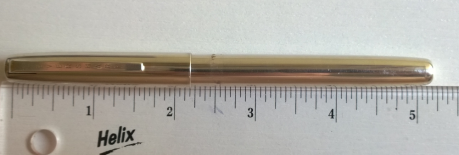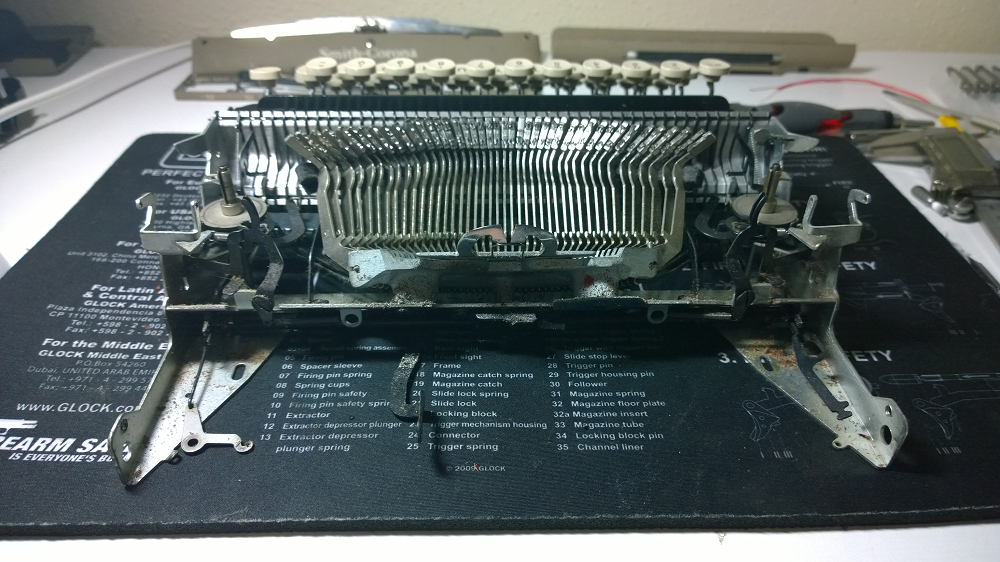Alright guys n’ gals. I figured I’d start posting up tidbits about the fountain pens I own. These type of posts — since this is the first, I’ll get this out of the way — are part informational, part review. I am a user of fountain pens first and a collector second. My philosophy toward typewriters (that they should be used if they can be) applies to fountain pens and in fact fountain pens is where that idea came to be.
Today, I’d like to talk about the Eversharp Slim Ventura.
This line was Eversharp’s last real attempt at making a quality pen. All pens after this dropped dramatically in quality as well as cost. As a last attempt, or possibly more accurately a farewell, I think they did an admirable job. These pens were produced in a variety of colors. These had plastic barrels and metal caps in three grades: gold filled cap and clip, sterling cap with gold filled clip, and gold filled cap with sterling clip. To these they added two metal versions: gold filled and sterling silver.
The set that I have is sterling silver. It includes a fountain pen (set with a fine point, non-flexible 14k gold nib) and a click actuated mechanical pencil. When I got this set, it was NOS (new old stock) from c. 1955! How cool is that?! It came from these awesome folks here and with the original boxes, price tags, instructions, and plastic around the pens. (The price tags have since gone missing, because… well, I’m a user not a collector.) And interesting tidbit is the sterling silver version is the only version to have a sterling cap with a sterling clip.
First and foremost, I simply adore this case! Some of the pens I own come with shoddy, questionable at best, boxes even though they cost a decent amount (in my book). This box has character. It’s nice to the touch and solid, with the name emblazoned upon the lid. Straight out of the box, everything worked like a charm! I ink up old(er) pens with an ink that I know is neutral toward their ink sacs. In this case, it’s old reliable: Waterman’s Mysterious Blue, formerly Blue-Black. (I should mention here that the ink sac in the pen is the original one! A testament to how well things were made back then, eh?)
Straight out of the box, everything worked like a charm! I ink up old(er) pens with an ink that I know is neutral toward their ink sacs. In this case, it’s old reliable: Waterman’s Mysterious Blue, formerly Blue-Black. (I should mention here that the ink sac in the pen is the original one! A testament to how well things were made back then, eh?)
The nib is un-frickin’-believable. Ultra smooth and flawless. There is a down-turn to the nib which gives its stiffness, but there is also a slight degree of spring due to the inherent properties of 14k gold. Though the nib is stiff, it is nothing near manifold stiffness. (The blotch on the nib isn’t damage, but ink…)
The weight is pleasant and since it’s sterling, there’s definitely a degree of heft. With the cap posted, the weight is toward the rear, which is excellent for this pen as it doesn’t take very much pressure to get the ink flowing. The length is also easy going. The width is obviously smaller than other pens (as suggested by its name) but it isn’t too small for long-term writing.

Closed Length is about 5 3/16″.

Posted length, about 6 1/8″.
The pencil is a bit more difficult to handle, especially if you’ve got larger paws like I do. Its stream-lined, aerodynamic nature that cuts through the air so you can precisely jot down ideas and musings makes it rather difficult to grip without it slipping occasionally. Another nit-picky complaint is that the click actuation to get the lead out is incredibly stiff. To my knowledge, this is on par with the mechanical pencils of the age but… wow, really stiff. 
The lead in the pencil is original as well as the eraser — which is unusable, but understandably so, since, after all, it is well over 50 years old! The lead is definitely thick for me but totally on par with the era, at 1.1mm or thereabouts. (I personally prefer 0.5mm for mechanical pencils.) Hardness is… about HB, which is standard.
Overall, the cost for this set was well worth it. I carry the pencil in my bag while I have the fountain pen in my pocket. Since it is a set, I enjoy it even more since sets have that matching allure. The pencil, unfortunately, goes more often unused partially due to its shape — not fixable — and its lead softness — fixable. Both are great daily users/writers and are in my rotation.
Hope y’all enjoyed this! Have a great day and be safe out there.












